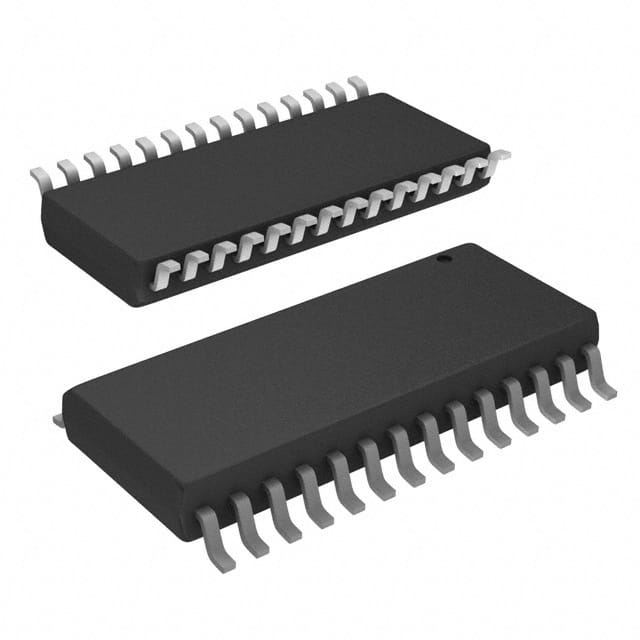AT28C64E-15SC
Product Overview
Category
AT28C64E-15SC belongs to the category of electrically erasable programmable read-only memory (EEPROM) chips.
Use
This product is primarily used for non-volatile data storage in various electronic devices such as microcontrollers, computers, and consumer electronics.
Characteristics
- Non-volatile: The stored data remains even when power is removed.
- Electrically erasable: The memory can be erased and reprogrammed electronically.
- High storage capacity: The AT28C64E-15SC has a capacity of 64 kilobits (8 kilobytes).
- Low power consumption: It operates at low voltage and consumes minimal power.
- Fast access time: The chip provides quick access to stored data.
Package
The AT28C64E-15SC comes in a small outline integrated circuit (SOIC) package. This package type ensures easy integration into various electronic systems.
Essence
The essence of this product lies in its ability to store and retrieve data reliably, making it an essential component in many electronic devices.
Packaging/Quantity
The AT28C64E-15SC is typically packaged in reels or tubes, with each reel or tube containing a specific quantity of chips. The exact quantity may vary depending on the manufacturer's specifications.
Specifications
- Memory Capacity: 64 kilobits (8 kilobytes)
- Supply Voltage: 2.7V to 5.5V
- Access Time: 150 nanoseconds
- Operating Temperature Range: -40°C to +85°C
- Data Retention: More than 10 years
Detailed Pin Configuration
The AT28C64E-15SC has a total of 28 pins. The pin configuration is as follows:
- A0 - Address Input
- A1 - Address Input
- A2 - Address Input
- A3 - Address Input
- A4 - Address Input
- A5 - Address Input
- A6 - Address Input
- A7 - Address Input
- VCC - Power Supply
- OE - Output Enable
- CE - Chip Enable
- WE - Write Enable
- I/O0 - Data Input/Output
- I/O1 - Data Input/Output
- I/O2 - Data Input/Output
- I/O3 - Data Input/Output
- I/O4 - Data Input/Output
- I/O5 - Data Input/Output
- I/O6 - Data Input/Output
- I/O7 - Data Input/Output
- NC - No Connection
- GND - Ground
- NC - No Connection
- NC - No Connection
- NC - No Connection
- NC - No Connection
- NC - No Connection
- NC - No Connection
Functional Features
- Easy data storage and retrieval: The AT28C64E-15SC allows for simple read and write operations, making it user-friendly.
- High reliability: The EEPROM technology ensures reliable data retention and endurance.
- Flexible programming options: The chip supports both byte and page-level programming, providing flexibility in data manipulation.
Advantages and Disadvantages
Advantages
- Non-volatile memory: Data remains intact even during power loss or system shutdown.
- Electrically erasable: Allows for easy reprogramming without the need for physical removal.
- Compact size: The small package size enables integration into space-constrained electronic devices.
- Low power consumption: Operates efficiently with minimal power requirements.
Disadvantages
- Limited storage capacity: The AT28C64E-15SC has a relatively small capacity compared to other memory options.
- Slower access time: The access time of 150 nanoseconds may be slower compared to some newer memory technologies.
Working Principles
The AT28C64E-15SC utilizes EEPROM technology, which allows for electrically erasing and reprogramming data. It consists of a grid of memory cells that can be individually addressed and manipulated. When data is written, an electrical charge is applied to the specific memory cell, altering its state. This altered state represents the stored data. During read operations, the stored data is retrieved by sensing the electrical state of each memory cell.
Detailed Application Field Plans
The AT28C64E-15SC finds applications in various fields, including:
- Microcontrollers: Used for storing firmware, configuration settings, and calibration data.
- Computers: Employed in BIOS chips and other non-volatile memory requirements.
- Consumer Electronics: Integrated into devices such as smart TVs, set-top boxes, and gaming consoles for data storage purposes.
Detailed and Complete Alternative Models
- AT28C256
قم بإدراج 10 أسئلة وإجابات شائعة تتعلق بتطبيق AT28C64E-15SC في الحلول التقنية
Sure! Here are 10 common questions and answers related to the application of AT28C64E-15SC in technical solutions:
Q: What is the AT28C64E-15SC? A: The AT28C64E-15SC is a 64K (8K x 8) Electrically Erasable Programmable Read-Only Memory (EEPROM) chip.
Q: What is the operating voltage range for the AT28C64E-15SC? A: The AT28C64E-15SC operates within a voltage range of 4.5V to 5.5V.
Q: What is the maximum clock frequency supported by the AT28C64E-15SC? A: The AT28C64E-15SC supports a maximum clock frequency of 150 ns.
Q: Can the AT28C64E-15SC be used for storing program code? A: Yes, the AT28C64E-15SC can be used for storing program code as it is an EEPROM memory chip.
Q: How many bytes of data can the AT28C64E-15SC store? A: The AT28C64E-15SC can store up to 64 kilobytes (64,000 bytes) of data.
Q: Is the AT28C64E-15SC compatible with microcontrollers and other digital devices? A: Yes, the AT28C64E-15SC is compatible with most microcontrollers and digital devices that support EEPROMs.
Q: Can the AT28C64E-15SC be reprogrammed multiple times? A: Yes, the AT28C64E-15SC is electrically erasable and can be reprogrammed multiple times.
Q: What is the typical endurance of the AT28C64E-15SC? A: The AT28C64E-15SC has a typical endurance of 100,000 erase/write cycles.
Q: Does the AT28C64E-15SC require any external components for operation? A: No, the AT28C64E-15SC does not require any external components for basic operation.
Q: Can the AT28C64E-15SC operate in harsh environmental conditions? A: Yes, the AT28C64E-15SC is designed to operate in a wide temperature range (-40°C to +85°C) and is suitable for various environments.
Please note that these answers are general and may vary depending on specific application requirements and datasheet specifications.


